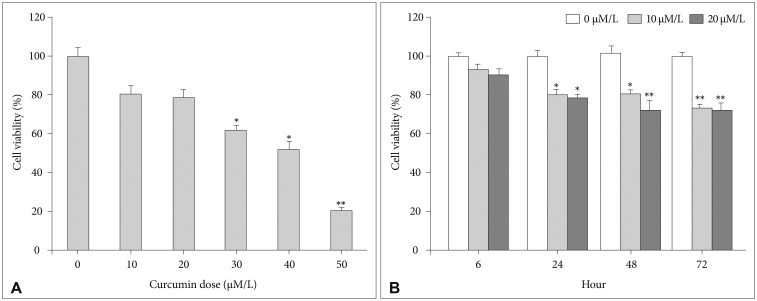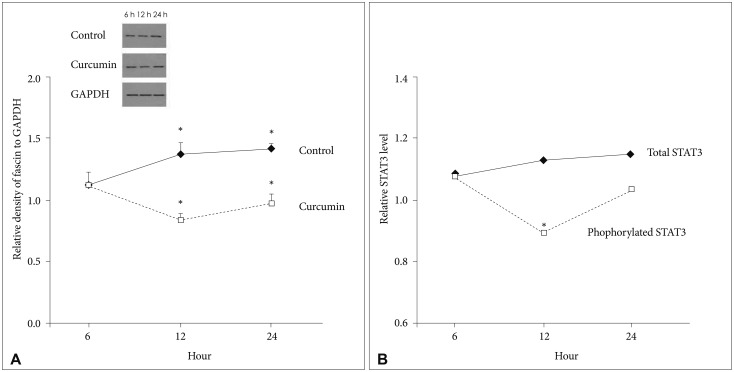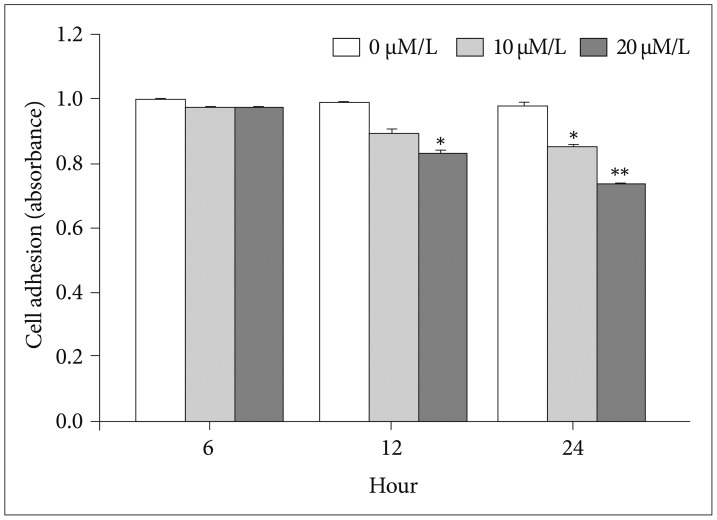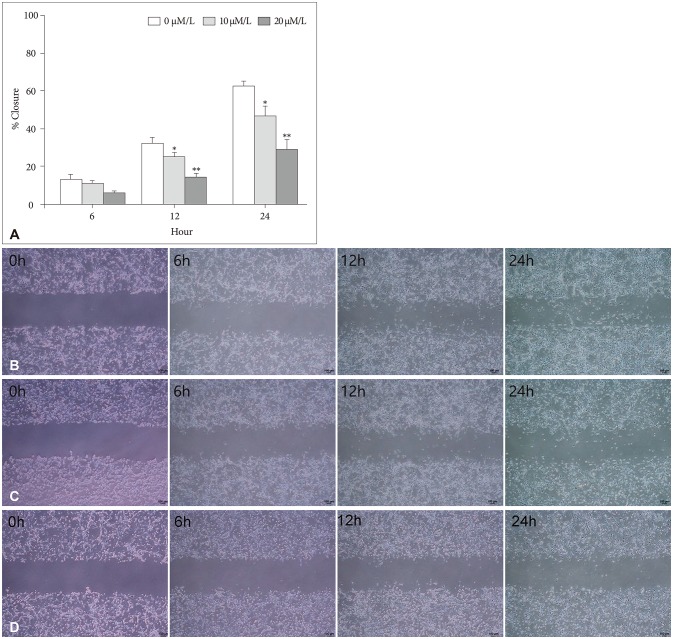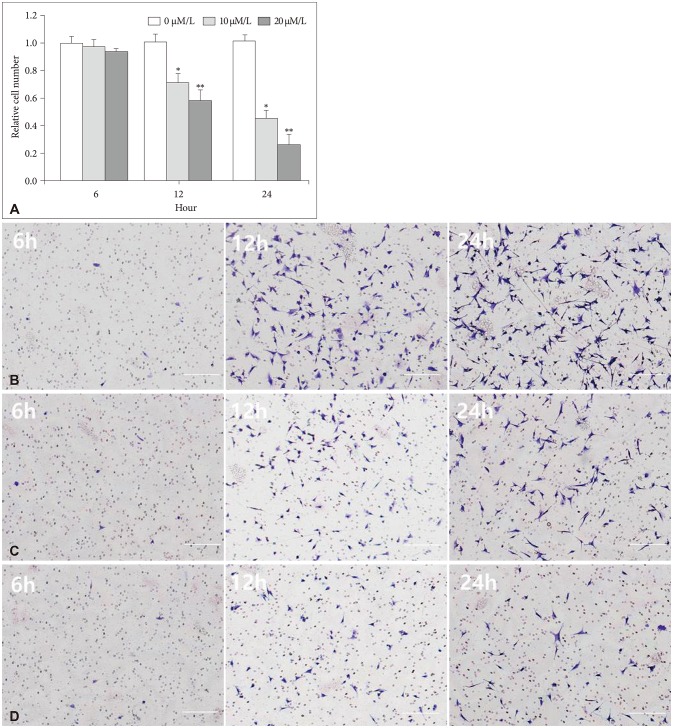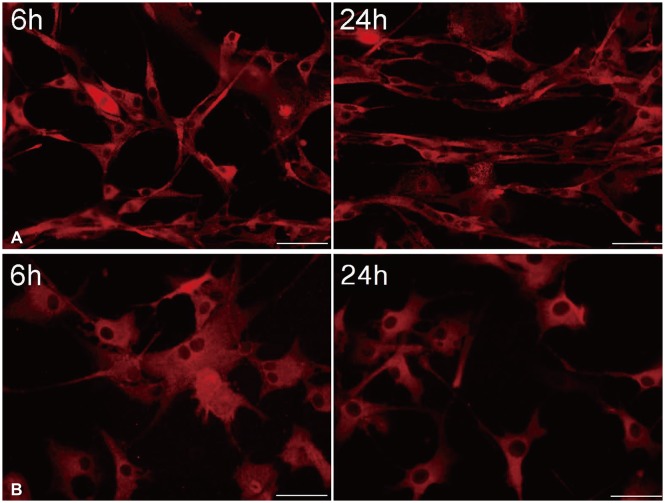Brain Tumor Res Treat.
2019 Apr;7(1):16-24. 10.14791/btrt.2019.7.e28.
Anti-Migration and Anti-Invasion Effects of Curcumin via Suppression of Fascin Expression in Glioblastoma Cells
- Affiliations
-
- 1Department of Neurosurgery, School of Medicine, Kyungpook National University, Daegu, Korea. jhwang@knu.ac.kr
- KMID: 2444791
- DOI: http://doi.org/10.14791/btrt.2019.7.e28
Abstract
- BACKGROUND
The natural compound curcumin was known to inhibit migration and invasion of glioblastoma (GBM) cells. Fascin, a kind of actin-binding proteins, is correlated with migration and invasion of GBM cells. The purpose of this study was to investigate anti-migration and anti-invasion effects of curcumin via suppression of fascin expression in GBM cells.
METHODS
U87 cell line was used as an experimental model of GBM. Fascin was quantified by Western blot analysis. And, the signal transducer and activator of transcription 3 (STAT3), known to play an important role in migration and invasion of tumor cells, were analyzed by sandwich-ELISA. Migration and invasion capacities were assessed by attachment, migration and invasion assays. Cellular morphology was demonstrated by immunofluorescence.
RESULTS
At various concentrations of curcumin and exposure times, fascin expression decreased. After temporarily exposure to 10 µM/L curcumin during 6 hours as less invasive concentration and time, fascin expression temporarily decreased at 12 hours (18.4%, p=0.024), and since then recovered. And, the change of phosphrylated STAT3 level also reflected the temporarily decreased pattern of fascin expression at 12 hours (19.7%, p=0.010). Attachment, migration, and invasion capacities consistently decreased at 6, 12, and 24 hours. And, immunofluorescence showed the change of shape and the reduction of filopodia formation in cells.
CONCLUSION
Curcumin is likely to suppress the fascin expression in GBM cells, and this might be a possible mechanism for anti-migration and anti-invasion effects of Curcumin via inhibition of STAT3 phosphorylation.
Keyword
MeSH Terms
Figure
Reference
-
1. Hwang JH, Smith CA, Salhia B, et al. The role of fascin in the migration and invasiveness of malignant glioma cells. Neoplasia. 2008; 10:149–159. PMID: 18283337.
Article2. Park KS, Lee HW, Park SH, et al. The clinical significance of fascin expression in a newly diagnosed primary glioblastoma. J Neurooncol. 2016; 129:495–503. PMID: 27406586.
Article3. Roma AA, Prayson RA. Fascin expression in 90 patients with glioblastoma multiforme. Ann Diagn Pathol. 2005; 9:307–311. PMID: 16308158.
Article4. Al-Alwan M, Olabi S, Ghebeh H, et al. Fascin is a key regulator of breast cancer invasion that acts via the modification of metastasis associated molecules. PLoS One. 2011; 6:e27339. PMID: 22076152.5. Yao J, Qian CJ, Ye B, et al. Signal transducer and activator of transcription 3 signaling upregulates fascin via nuclear factor-κB in gastric cancer: implications in cell invasion and migration. Oncol Lett. 2014; 7:902–908. PMID: 24527098.
Article6. Gunal A, Onguru O, Safali M, et al. Fascin expression [corrected] in glial tumors and its prognostic significance in glioblastomas. Neuropathology. 2008; 28:382–386. PMID: 18298442.7. Joo JD, Kim H, Kim YH, et al. Validation of the effectiveness and safety of temozolomide during and after radiotherapy for newly diagnosed glioblastomas: 10-year experience of a single institution. J Korean Med Sci. 2015; 30:1597–1603. PMID: 26539003.
Article8. Peraud A, Mondal S, Hawkins C, et al. Expression of fascin, an actin-bundling protein, in astrocytomas of varying grades. Brain Tumor Pathol. 2003; 20:53–58. PMID: 14756441.
Article9. Sordillo LA, Sordillo PP, Helson L. Curcumin for the treatment of glioblastoma. Anticancer Res. 2015; 35:6373–6378. PMID: 26637846.10. Aggarwal BB, Kumar A, Bharti AC. Anticancer potential of curcumin: preclinical and clinical studies. Anticancer Res. 2003; 23:363–398. PMID: 12680238.11. López-Lázaro M. Anticancer and carcinogenic properties of curcumin: considerations for its clinical development as a cancer chemopreventive and chemotherapeutic agent. Mol Nutr Food Res. 2008; 52(Suppl 1):S103–S127. PMID: 18496811.
Article12. Hartojo W, Silvers AL, Thomas DG, et al. Curcumin promotes apoptosis, increases chemosensitivity, and inhibits nuclear factor kappaB in esophageal adenocarcinoma. Transl Oncol. 2010; 3:99–108. PMID: 20360934.13. Belkaid A, Copland IB, Massillon D, et al. Silencing of the human microsomal glucose-6-phosphate translocase induces glioma cell death: potential new anticancer target for curcumin. FEBS Lett. 2006; 580:3746–3752. PMID: 16777101.
Article14. Nagai S, Kurimoto M, Washiyama K, et al. Inhibition of cellular proliferation and induction of apoptosis by curcumin in human malignant astrocytoma cell lines. J Neurooncol. 2005; 74:105–111. PMID: 16193380.
Article15. Patel BB, Gupta D, Elliott AA, et al. Curcumin targets FOLFOX-surviving colon cancer cells via inhibition of EGFRs and IGF-1R. Anticancer Res. 2010; 30:319–325. PMID: 20332435.16. Senft C, Polacin M, Priester M, et al. The nontoxic natural compound Curcumin exerts anti-proliferative, anti-migratory, and anti-invasive properties against malignant gliomas. BMC Cancer. 2010; 10:491. PMID: 20840775.
Article17. Woo MS, Jung SH, Kim SY, et al. Curcumin suppresses phorbol ester-induced matrix metalloproteinase-9 expression by inhibiting the PKC to MAPK signaling pathways in human astroglioma cells. Biochem Biophys Res Commun. 2005; 335:1017–1025. PMID: 16102725.
Article18. Parsa AT. A newly identified transcriptional network for mesenchymal transformation of brain tumors: potential targets for therapeutic intervention. World Neurosurg. 2010; 73:424. PMID: 20920910.
Article19. Adams JC. Formation of stable microspikes containing actin and the 55 kDa actin bundling protein, fascin, is a consequence of cell adhesion to thrombospondin-1: implications for the anti-adhesive activities of thrombospondin-1. J Cell Sci. 1995; 108(Pt 5):1977–1990. PMID: 7657718.
Article20. Adams JC. Characterization of cell-matrix adhesion requirements for the formation of fascin microspikes. Mol Biol Cell. 1997; 8:2345–2363. PMID: 9362073.
Article21. Adams JC, Kureishy N, Taylor AL. A role for syndecan-1 in coupling fascin spike formation by thrombospondin-1. J Cell Biol. 2001; 152:1169–1182. PMID: 11257118.
Article22. Edwards RA, Bryan J. Fascins, a family of actin bundling proteins. Cell Motil Cytoskeleton. 1995; 32:1–9. PMID: 8674129.
Article23. Edwards RA, Herrera-Sosa H, Otto J, et al. Cloning and expression of a murine fascin homolog from mouse brain. J Biol Chem. 1995; 270:10764–10770. PMID: 7738015.
Article24. Kureishy N, Sapountzi V, Prag S, et al. Fascins, and their roles in cell structure and function. Bioessays. 2002; 24:350–361. PMID: 11948621.
Article25. Vignjevic D, Kojima S, Aratyn Y, et al. Role of fascin in filopodial protrusion. J Cell Biol. 2006; 174:863–875. PMID: 16966425.
Article26. Kunnumakkara AB, Anand P, Aggarwal BB. Curcumin inhibits proliferation, invasion, angiogenesis and metastasis of different cancers through interaction with multiple cell signaling proteins. Cancer Lett. 2008; 269:199–225. PMID: 18479807.
Article27. Dhandapani KM, Mahesh VB, Brann DW. Curcumin suppresses growth and chemoresistance of human glioblastoma cells via AP-1 and NFkappaB transcription factors. J Neurochem. 2007; 102:522–538. PMID: 17596214.28. Kunnumakkara AB, Diagaradjane P, Anand P, et al. Curcumin sensitizes human colorectal cancer to capecitabine by modulation of cyclin D1, COX-2, MMP-9, VEGF and CXCR4 expression in an orthotopic mouse model. Int J Cancer. 2009; 125:2187–2197. PMID: 19623659.
Article29. Sandur SK, Deorukhkar A, Pandey MK, et al. Curcumin modulates the radiosensitivity of colorectal cancer cells by suppressing constitutive and inducible NF-kappaB activity. Int J Radiat Oncol Biol Phys. 2009; 75:534–542. PMID: 19735878.30. Gao X, Deeb D, Jiang H, et al. Curcumin differentially sensitizes malignant glioma cells to TRAIL/Apo2L-mediated apoptosis through activation of procaspases and release of cytochrome c from mitochondria. J Exp Ther Oncol. 2005; 5:39–48. PMID: 16416600.31. Karmakar S, Banik NL, Patel SJ, et al. Curcumin activated both receptor-mediated and mitochondria-mediated proteolytic pathways for apoptosis in human glioblastoma T98G cells. Neurosci Lett. 2006; 407:53–58. PMID: 16949208.
Article32. Kim SY, Jung SH, Kim HS. Curcumin is a potent broad spectrum inhibitor of matrix metalloproteinase gene expression in human astroglioma cells. Biochem Biophys Res Commun. 2005; 337:510–516. PMID: 16198311.
Article
- Full Text Links
- Actions
-
Cited
- CITED
-
- Close
- Share
- Similar articles
-
- Curcumin Inhibits the Proliferation, Migration, Invasion, and Apoptosis of Diffuse Large B-Cell Lymphoma Cell Line by Regulating MiR-21/VHL Axis
- Effect of Curcumin on Cancer Invasion and Matrix Metalloproteinase-9 Activity in MDA-MB-231 Human Breast Cancer Cell
- Proteases are Modulated by Fascin in Oral Cancer Invasion
- The Prognostic Significance of Fascin Expression in Colorectal Carcinoma
- Curcumin-Induced Autophagy Augments Its Antitumor Effect against A172 Human Glioblastoma Cells

